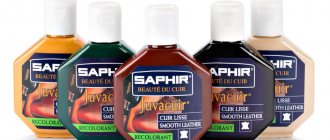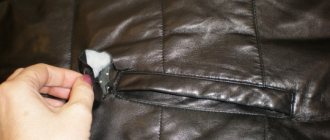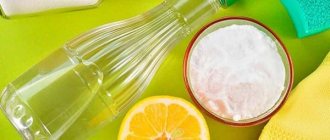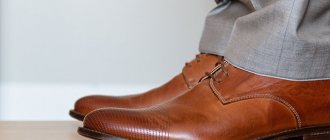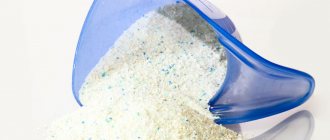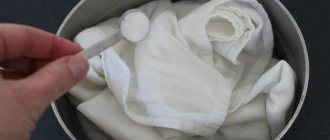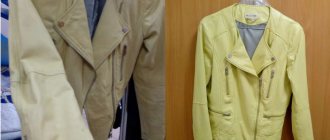Useful tips
Regular rain can seriously damage your leather jacket (vest, jacket, raincoat), which, when in contact with moisture, can lose its appearance and even be damaged.
For this reason, you need to know how to care for leather clothing
so that when you get home you can immediately take care of her. And to do this, you should know a few rules for cleaning leather items.
How to care for a leather jacket
Useful tips on how to clean a leather jacket
How to Clean a White Leather Jacket
How to iron a leather jacket
How to wash a leather jacket
How can you update an old leather jacket?
In specialized stores, when a buyer asks how to update an old leather jacket with his own hands, they offer to buy a leather stretching agent in the form of an aerosol. After treatment with stretching liquid, colorless shoe wax is applied to the surface. It can only be used on smooth skin.
Interesting materials:
Is it possible to connect a phone to an old TV? Can I use a mobile phone at school? Can I use a phone in the intensive care ward? Can I use my phone on a plane 2022? Is it possible to change Android on a phone? Is it possible to change only one glass on a phone? Is it possible to change the owner of a phone number? Is it possible to top up your phone balance through a Sberbank terminal? Is it possible to top up my phone with bonus plus? Is it possible to view a flash drive on a phone?
Tools Overview
Professional products are mainly used to care for leather products. However, in some cases, more affordable products such as paraffin or glycerin can help restore the condition of the jacket. When processing artificial leather, it is recommended to use oilier products.
Professional products
Professional skin care products are considered more preferable, as they contain substances necessary to preserve the material in its original form.
Products for water resistance
Water-repellent sprays will be required if the leather product is stored in a damp area or worn in damp weather. These products include products that include:
- natural fat;
- wax;
- acrylic;
- silicone
Air conditioners
Conditioners are used to restore fat balance, thereby reducing the likelihood of cracks and increasing the wear resistance of the jacket. Such products are recommended for use in cases where the leather product has lost its former elasticity. During private processing, the structure of the material changes.
Polishing
Polishes are used to restore the former shine. But, as with other products described, this product should not be applied continuously. When used privately, polish accelerates leather wear.
Stain removers
Creams, gels or sprays are used to remove stains. These products can be used constantly. Among the stain removers, products from the Salamander, Ecco and Salton brands stand out, which provide a pronounced and long-lasting effect.
Natural oils
To soften the skin, use sea buckthorn, castor, sunflower, burdock or olive oil. It is recommended to treat the jacket with these products as needed. To achieve this effect, you will need to apply no more than 2-3 drops (sunflower - 1 drop) of oil to the problem area, squeeze for 2-3 hours and remove the excess.
Glycerol
Glycerin is used to prevent damage and restore leather products. The jacket needs to be treated with this substance. Then you need to wait 1-2 hours, after which the product is suitable for wearing. After application, glycerin does not leave greasy stains.
Body cream
Nourishing or moisturizing creams are used to treat leather jackets. This product is applied to the product with a soft sponge. Then the jacket must be left for at least 12 hours. Body creams are used to remove traces of paint or coffee, as well as to improve the appearance of the product.
Beeswax ointment
This product restores and nourishes the skin. The ointment must first be melted in a water bath and mixed with a small amount of turpentine. Next, you need to treat problem areas on the jacket with the resulting composition. Thanks to this mixture, the skin becomes softer and stains after precipitation disappear.
Goose fat
This option is rarely used, but after treatment with goose fat the effect is significantly better. This product is used to eliminate abrasions, including on old leather items. Along the way, goose fat softens the material. After treating the jacket with this product, you need to leave the product overnight and wipe it with a cotton rag in the morning.
Stationery chalk and potato starch
Chalk or starch must be diluted in water to achieve a paste-like consistency. Then the resulting composition should be evenly distributed over the surface, left for half an hour and rinsed with water. At the end, the skin should be wiped dry and treated with glycerin.
To remove grease stains and dirt, restore the original color and soften the material, it is recommended to use a mixture of heated milk and a small amount of turpentine.
Ways to get rid of scratches
Removing mechanical damage - scratches and abrasions - requires care and special tools (both improvised and professional):
We recommend:
How to choose the density of a terry towel - types of towels
- Orange peel. Whitish areas can be refreshed with citrus fruits. The best remedy is orange peel. With its outer side you need to carefully rub the defects.
- Glycerin solution. Glycerin diluted with water in equal proportions helps remove deep creases and small cracks. They need to treat the “wounds” without washing it off.
- Nail polish. A colorless nail polish can be used to seal small tears. You need to pour the varnish into the crack as carefully as possible (it’s convenient to use a toothpick) and press with your fingers for two to three minutes. You can also use instant glue.
- Liquid Leather. Special “liquid skin” for filling defects should be used according to the manufacturer’s instructions.
Features of care
Due to the fact that leather jackets do not tolerate contact with water and elevated temperatures, it is recommended to clean such products with a soap solution, which is applied to the item using a foam sponge.
General prevention
To extend the life of such products, it is recommended to treat such items with nutritional compounds every month. If the jacket is made of artificial leather, the procedure should be carried out once every 2-3 weeks.
Minor scratches
To remove minor scratches, use natural oils, glycerin or professional products. But the best choice is beeswax, which glues the skin together.
Deep folds
Goose fat helps to cope with the problem of deep folds. If this remedy is not available, olive or sunflower oil can be used to eliminate such a defect. In addition, high-fat body cream helps get rid of wrinkles.
Scuffs
It is impossible to completely eliminate such a defect. Therefore, in the fight against abrasions, the described products are used that improve the condition of the skin.
Worn and faded appearance
Glycerin, burdock and castor oil help get rid of this defect. It is recommended to treat the jacket with these products 2-3 times, after which you need to take a week break. If necessary, the procedure should be repeated.
What can't you do?
Leather jackets should not be dried on radiators or in close proximity to heat sources. In this case, the material quickly cracks. Also, the product should not be kept in direct sunlight for a long time, stored in plastic bags and machine washed.
Reasons for rigidity
Before moving on to softening methods, it is necessary to understand why this happens with such material.
There are several possible reasons:
- The very first thing is the quality of the leather jacket. Always check with the seller what the leather is made of, what animal skin was used, whether it is really natural or not.
- The jacket becomes stiff if the item is not stored correctly. Most people put their outerwear in a common closet without considering the conditions in it. Leather should not be stored in a very damp place. Just like you shouldn’t place a jacket in a closet with low air humidity. Dry air literally sucks moisture out of your skin, making it hard. Optimal humidity is 40–50%.
Therefore, it is so important to adhere to the rules for storing and drying leather products after washing.
Cleansing different skin types
Bags, purses, belts and shoes can be made from different types of genuine leather. The method of cleansing the skin depends on the method of dressing - each case requires its own means and methods. Here are the main ones.
- Smooth skin. The goal is not just to cleanse such skin, but to make it shine beautifully. A solution of citric acid will help with this. After cleaning with soapy water - it is described in detail above how to do this correctly - the bag is wiped dry and then lubricated with an acid solution. To prepare it, dissolve a teaspoon of citric acid crystals in a liter of warm water. Then the product needs to be thoroughly rubbed with a soft cloth.
- Polished leather. This type is considered the most capricious. Patent leather products cannot be used at temperatures below ten degrees below zero or above twenty-five degrees above zero, otherwise they will begin to fade, bubble, dry out and crack or melt. If patent leather becomes dirty, use only clean warm water and a soft cloth to clean it. Be sure to wipe the product dry after processing.
- Hairy skin. Suede and nubuck are no less capricious than leather with a glossy finish. Under no circumstances should it be wetted if stains appear on the product - they are carefully removed with a cotton sponge soaked in acetone or gasoline. then the product is held over hot steam for several minutes, after which it is treated with a special brush. You can also wipe the items with water and vinegar or lemon juice - this will restore the color and softness of the fleecy leather. A tablespoon of vinegar essence or lemon juice is enough for a liter of water. Light-colored suede items can be perfectly cleaned and restored with a mixture of warmed milk and baking soda. Finally, you should treat your bag, jacket or shoes with a water-repellent spray specifically for suede and nubuck items.
- Artificially aged leather. Accessories and outerwear in shabby chic or vintage style are very fashionable now. But if the jacket was worn from the original “from the manufacturer”, this does not mean that you can not take care of it at all. Dust and dirt from such leather are removed with a regular damp sponge; stains can be removed with gasoline or a solution of ammonia. To soften the rubbed skin, apply Vaseline.
- Embossed leather and reptile leather or imitated leather. This is also a very trendy material, not the first season. Such products need to be cleaned of dust every day, preventing it from accumulating on the embossed surface. Then the handbag or wallet is treated with oil or glycerin. If dirt has nevertheless accumulated in the hollows and depressions, it is convenient to remove it using a cotton swab dipped in a solution of ammonia.
These were the simplest and most affordable ways to clean the main types of leather. Using them, you will always have beautiful and well-groomed accessories. Little tricks and useful tips from experienced housewives will help keep them that way for a long time.
Cleansing dark and light skin
Natural ground coffee contains essential oils that perfectly nourish natural skin. And the coloring pigment masks scuffs and restores bright color. You can use the grounds from the coffee you just drank.
Or prepare a fresh mixture: to do this, dissolve a heaped teaspoon of ground coffee in two tablespoons of hot water. The resulting mixture is applied to the leather product using a cotton swab, left for ten minutes, and the residue is removed with a damp sponge. After this, the handbag, shoes or jacket should be polished with a flannel cloth.
Important points:
- You should only use finely ground coffee and under no circumstances rub the grounds intensely into the skin - this can scratch it;
- the thickener should be thick, but not very liquid; excess moisture is very harmful to the skin;
- If the leather product does get wet, it is dried naturally at room temperature; there is no need to speed up the process with a hairdryer or radiator.
We invite you to familiarize yourself with Creating a toy storage system in a children's room
Light leather can be cleaned with ammonia. But not pure, the following solution is prepared with this substance:
- warm water - 150 ml;
- liquid soap - a tablespoon;
- ammonia alcohol - a tablespoon.
To further soften and nourish the skin after cleansing, it is recommended to lubricate it with castor oil or glycerin. You can also use refined petroleum jelly. The product is applied, lightly rubbing in, and left to soak in for a quarter of an hour. After this, the excess is removed with a napkin.
Wax is another substance that can help
Surprisingly, even the wax left over from a candle will be a good help for those who want to soften their shoes. The method of use is simple: the candle is melted and the warm wax mass is applied to the desired area of the skin. Be extremely careful: do not touch the paraffin immediately after it has drained from the candle: it is too hot. After treatment, shoes need to be polished.
Recipes for adding shine
In order for the surface of the leather product to remain attractive, it must not only be cleaned, but also rubbed until shiny. Basic recipes:
- A strong effect can be achieved by wiping the surface with half an onion.
- a mixture of oil, turpentine and egg yolk.
- egg white.
- Orange peel.
After such procedures, it is necessary to apply glycerin to the skin.
To restore shine to your skin at home, you need to wrap coffee grounds in a flannel cloth and wipe the surface. However, white and light-colored products cannot be processed in this way.
Glycerin is good for treating leather
For white things, there is another recipe: you need to prepare a mixture of milk with beaten egg whites.
Quick help - Vaseline
This product is found in almost every home. Vaseline will soften and rejuvenate leather products. This product is ideal for light and elegant jackets, as it does not leave stains and has no foreign odor.
To restore a leather jacket, rub Vaseline all over it, squeezing it straight out of the tube until it is medium damp. After this, leave the item for 15-20 hours until completely absorbed.

